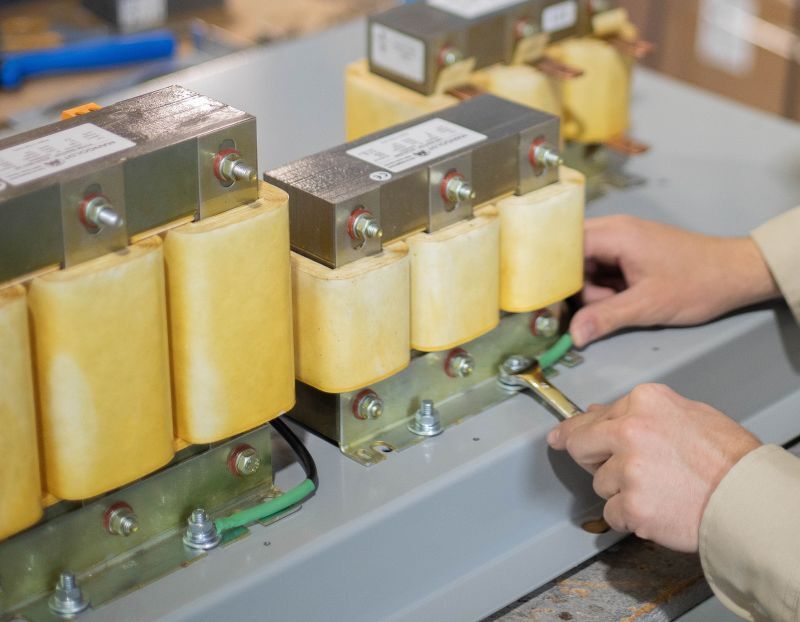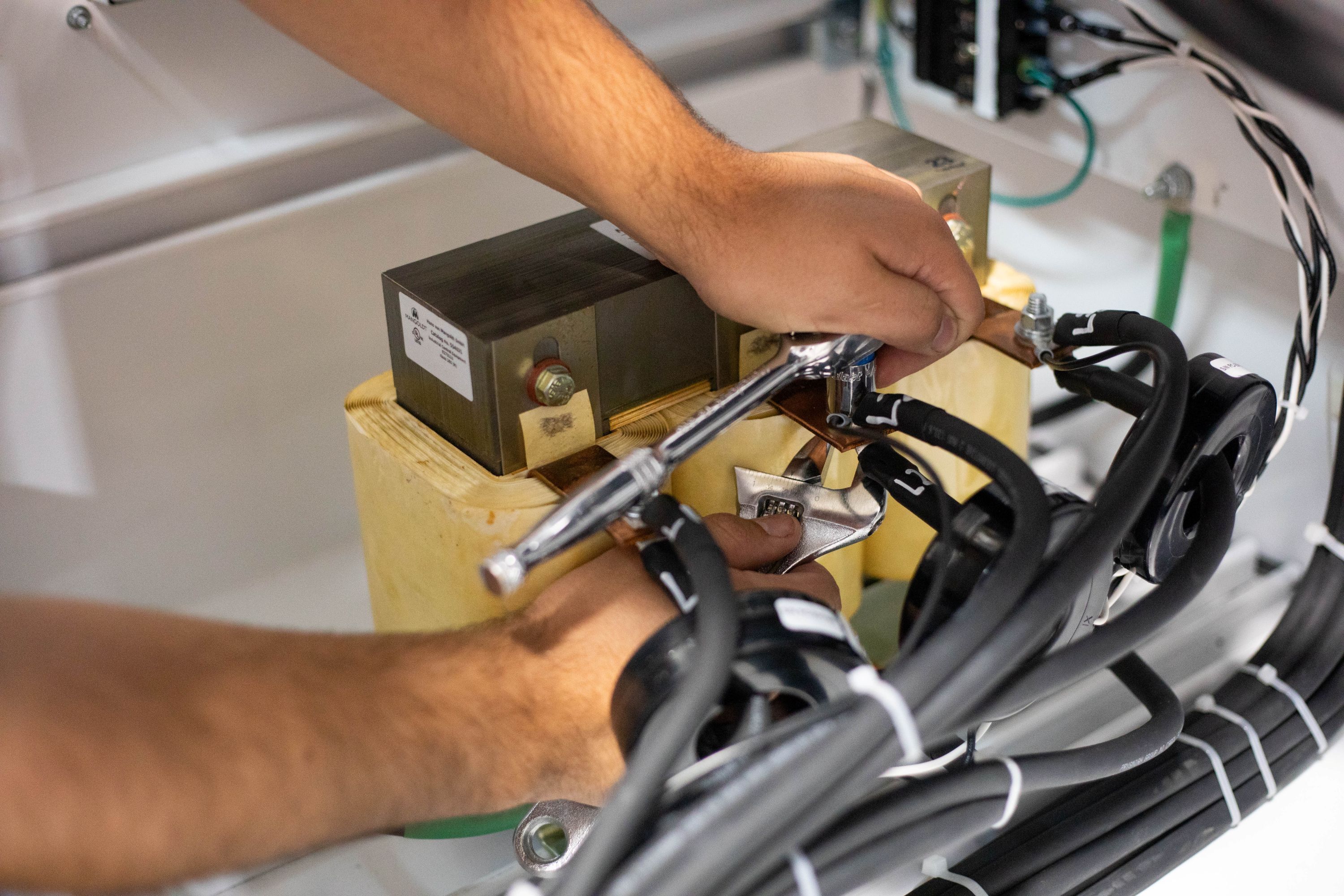How do You Size a Line Reactor?
Line reactors are a common component in variable frequency drive systems. They can help to control harmonics, dV/dt, surges, and other issues. On the incoming power side of a VFD, they’re often referred to as an input or line reactor, and on the outgoing power side they’re often referred to as a load or output reactor.
Many reactors are specified based on inductance, measured in the millihenry (mH) unit. Although it’s possible for you to look at your system and perform the calculations based on inductance, voltage, and other factors for the size of reactor needed, manufacturers have tried to simplify it for consumers.
Reactors are rated based on a specific voltage and amperage and given an impedance value. Once you know the general rules of sizing a reactor, using these measurements instead of inductance can make your life simpler. These general rules are split by the two common reactor applications: line and load.
Sizing Line Reactors
Although there are many unique or complicated applications, if you’re looking for the most basic harmonic mitigation, the general rule is to add a reactor with 3% impedance in front of your VFD. This will effectively mitigate about two thirds of the harmonics the VFD generates, as well as provide some surge suppression for the drive. While this won’t bring that specific VFD into compliance with IEEE 519 harmonic standards, it can be used in combination with other mitigation techniques across a facility to bring the entire system into compliance.
A line reactor is sized based on motor specifications. The most important pieces of information to know are the voltage of the system and the motor amperage, often written on the nameplate as the Amps, FLA, or MRA. With this information, you can find an appropriate reactor for the system. Be aware that the motor may occasionally run into overload that the VFD is programmed to allow, so you need to consider the overload when sizing the reactor. For most brands, the overload of the reactor is enough to cover most common motor applications.
Without the amperage, you could size the reactor based on horsepower, but this is less exact. If you don’t have the motor data, it’s possible to size a reactor based on the VFD specifications. In these cases, the most common error we see is that the reactor is sized too large, requiring extra cost and space, as well as reducing the effectivity of the harmonic filtration. VFDs are often sized slightly larger than the motor to provide some buffer. If you then add some additional buffer space on the reactor, or size based on horsepower, you may end up one or two sizes larger on the reactor than you truly need.
Let’s look at an example to try to make this make sense. Imagine we’re sizing a reactor for a Galt 50HP motor, part number GPT0500-4-326T-K. If this were running on a 480V system, the motor FLA would be 60 amps. An appropriate reactor for this application would be the Mangoldt ACL43-0066, which is rated for 66 amps, 3% impedance, and 480V. This matches the motor specs while also giving some buffer.
This motor is often paired with a Galt VFD, part number G540-00750UL-03. This pairing has some extra capability built into the sizing of the VFD. If you were to then size a reactor based on this VFD rather than the motor, you would need to plan for 75 amps, and you would unnecessarily increase the size of the reactor. This is a great example of why you should always try to get the motor amperage. (To find your motor amperage, read How to Read a Motor Nameplate)

What About Overload?
One of the important parts of sizing a VFD is to take the application into consideration. Rock crushers need a bit more room to go over their rated power than a fan or centrifugal pump do. This same concept applies to reactors.
It’s important to know the overload rating of the line of reactors you’re looking at. For example, the Mangoldt ACL reactor has a 150% overload rating for 60 seconds. For most VFDs, this is considered a moderately heavy-duty overload. Going back to our example above, the 6 extra amps of rating (66A reactor for a 60A motor) plus the 150% overload rating means this reactor should have the capacity to handle most applications the motor would face.
In general, the greater the overload rating, the more comfortable you would be having a line reactor’s rating close to a motor’s rating. If you have a 60A motor and a 60A reactor but almost no overload, you may need to look into upsizing the reactor.
Sizing Load Reactors
The actual sizing of load reactors is almost identical to line reactors, except that the general recommendation is to use a reactor with 5% impedance. The same motor information is required, and size is based on the FLA and voltage the same way.
Load reactors are usually only recommended for shorter cable distances between the VFD and motor. For example, Mangoldt reactors are recommended up to 1000 feet. They’re also not recommended on motors or cables that are submerged.
If the lead between the VFD and motor is over 1000 feet or the motor or cables are submerged, a sine wave filter would be recommended in place of a load reactor. A sine wave filter is a more advanced method of dealing with dV/dt, although it typically is more expensive. It also makes sense to use a sine wave filter when the cost of motor failure is high, whether because of high downtime costs, difficulty in pulling and placing the motor, or because a motor is custom and hard to repair or replace. This is because a sine wave filter outputs a much cleaner output wave form to the motor, reducing dV/dt and motor overheating.
On the same example motor as before, an ACL45-0065 would be a good reactor. This is a 480V, 65A, 5% impedance reactor.
Sizing Enclosures
Most reactors are bought as a standalone chassis with no electrical enclosure and would have an IP00 rating. If it needs to be enclosed into a panel, most manufacturers offer options. For Mangoldt, adding the suffix “-N1” will give you a NEMA 1 rated reactor, good for indoor applications. Adding a “-N3R” would give you a NEMA 3R rating, good for outdoor environments. Both may either be stocked products or custom builds. Another option is to integrate the reactor into the same panel the VFD will be in.

No matter which way you go, the reactor needs to be kept cool, clean, and dry, just like all electrical equipment. Out of these considerations, we most often see that customers underestimate the heat that needs to be dissipated as the reactor is used. Because of the magnetic function of a reactor, reactors can generate a significant amount of heat, and if that is enclosed and not dealt with, it can lead to failures in the electrical equipment.
Let Us Help!
Reactors can seem simple in their operation, but that doesn’t mean they’re always simple to integrate into your system. If you have questions, reach out to the VFDs.com team here, or call (800) 800-2261 and we can help you size the reactor you need for your system.
